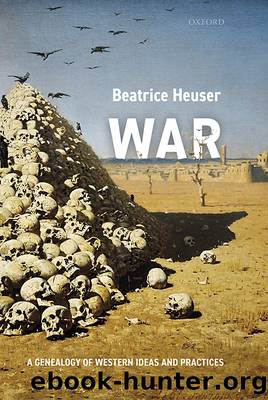War by Beatrice Heuser

Author:Beatrice Heuser [Heuser, Beatrice]
Language: eng
Format: epub
ISBN: 9780192517197
Publisher: OUP Oxford
Published: 2022-02-20T21:44:31+00:00
7
Who Fights?
Total Defence and Raiding Parties
Before considering who could, should, and can be a soldier, let us take a step back and consider why one would fight in a war in the first place. In the previous chapter we have read about a multitude of motivations, the first and foremost being to fight in self-defence when attacked. And who fights in that case? In a surprise raid conducted against a community, all its members would presumably feel the conflicting instincts to fight or hide or flee. Instincts can be conditioned to work in one sense rather than the other; even in physically weak people the rush of anger and the determination to protect oneâs family and property can lead to willingness to fight. One would assume that in a primitive society, in a raid on a village, anybody even remotely able to do so would fight, and many objects if handy could serve as a weapon, whether or not successfully wielded.
Once societies became more complex on the one hand, and on the other, when defending oneself and oneâs village had to be done with some degree of premeditation and organization, a division of labour was generally established. This would be even more pronounced if the military enterprise was not purely defensive, but consisted of a raid to recapture stolen goods, animals, or humans, or indeed to steal them from the villages of another tribe designated as the enemy. The village chief might delegate certain support tasks to the weaker members of the village, rounding up the stronger for the actual fighting itself. Fighting effectively with a sword, a pike, or a bow and arrows requires training, and a different sort of muscularity of that developed by hard agricultural labour. Even this fact alone would require some organization and some division of the population of a village into those who underwent the training and those who did not. Given overall differences in physical strength between men and women, between old and very young on the one hand and adults (especially young adults) on the other, given different dependencies and responsibilities (married men and women for their families), this singled out, in most societies, bacherlors as the fighters, with a particular preference for young men, with experienced men as leaders.
There is archaeological evidence illustrating this pattern particularly well. In around 3400 bce, a fortified village at Crickley Hill in England was attacked and destroyed: skeletons found outside the village enclosure were all male and mainly young, with arrow-heads lodged among their bones: the aggressors. Inside the enclosure, skeletal finds belonged to both sexes, and the cause of death had mainly been the impact of slashing weapons, with indications that both men and women were fighting defensively.1 Other sites give more information about the attackers: at the oldest documented European battle in the Tollense Valley in North-East Germany (c.1250 bce) all skeletal finds were of men, most of them young.2 Anthropologists have found a similar pattern of raids in primitive societies, but one
Download
This site does not store any files on its server. We only index and link to content provided by other sites. Please contact the content providers to delete copyright contents if any and email us, we'll remove relevant links or contents immediately.
Cecilia; Or, Memoirs of an Heiress — Volume 1 by Fanny Burney(32363)
Cecilia; Or, Memoirs of an Heiress — Volume 3 by Fanny Burney(31738)
Cecilia; Or, Memoirs of an Heiress — Volume 2 by Fanny Burney(31706)
The Great Music City by Andrea Baker(31082)
We're Going to Need More Wine by Gabrielle Union(18897)
All the Missing Girls by Megan Miranda(15347)
Pimp by Iceberg Slim(14196)
Bombshells: Glamour Girls of a Lifetime by Sullivan Steve(13923)
Talking to Strangers by Malcolm Gladwell(13123)
Fifty Shades Freed by E L James(13114)
Norse Mythology by Gaiman Neil(13111)
For the Love of Europe by Rick Steves(12174)
Crazy Rich Asians by Kevin Kwan(9115)
Mindhunter: Inside the FBI's Elite Serial Crime Unit by John E. Douglas & Mark Olshaker(9094)
The Lost Art of Listening by Michael P. Nichols(7353)
Enlightenment Now: The Case for Reason, Science, Humanism, and Progress by Steven Pinker(7078)
The Four Agreements by Don Miguel Ruiz(6532)
Bad Blood by John Carreyrou(6468)
Weapons of Math Destruction by Cathy O'Neil(6077)
